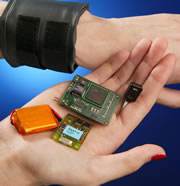A wearable device allows hospital inmates and the elderly to get out of bed and move around the hospital

German researchers have invented a wireless cuff that can monitor heart rate and blood oxygen levels. The invention will allow patients admitted to the hospital or the elderly to get out of their beds. The cuff includes an oximeter that measures both the heart rate and the amount of oxygen in the hemoglobin, and a transmitter that transfers the data to a computer. The system, presented at this month's Sevit exhibition in Hanover, Germany, frees patients from the tangle of cables of conventional monitoring devices.
The freedom of movement around the hospital can speed recovery, says Robert Schmidt, a researcher at the Fraunhofer Institute for Integrated Circuits in Erlangen, Germany, who was involved in the development of the cuff. This is especially true for those who are trying to get back on their feet after an injury. The cuff is designed in such a way that it is possible to integrate additional monitoring devices, such as sensors for body temperature, blood sugar level and blood pressure - says Schmidt. If the system discovers that the hospitalized or elderly person is going through a crisis, it calls the medical team.
body language
The cuff is part of a larger project of the Fraunhofer Institute called the Body Area Network. The system combines data from several sensors (for example from an electrocardiograph that listens to the heartbeat) that are attached to different areas of the body and transmit radio signals to a computer that is worn as a belt or cuff. The wearable computer processes the data and sends an integrated signal to the central computer of the local health services. Delivery can be made using standard wireless internet technology.
The data is encoded in a common language that is understood by all receivers. One of the computer languages being tested is the VITAL standard, says Schmidt. "The information should be in a standard format so that all doctors can examine the data." However, it will not be easy to convince the manufacturers to abandon the existing models in favor of the new technology. "The infrastructure must be replaced and this will only happen at the rate that the market will allow," adds Schmidt.
Michael Hopkins, Nature
